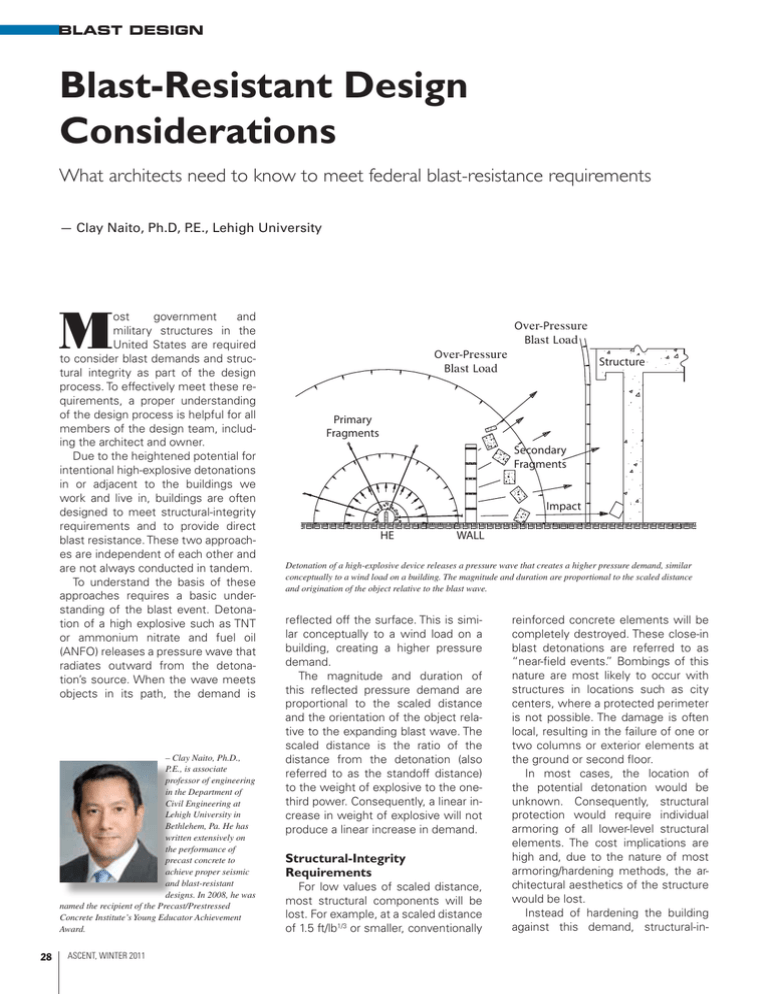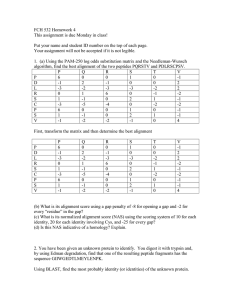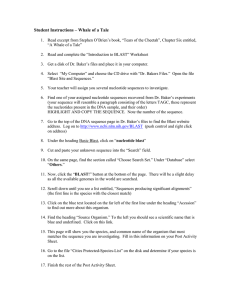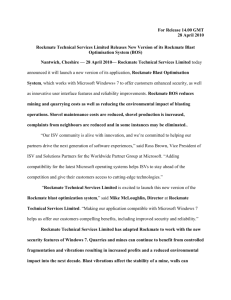Blast-Resistant Design Considerations
advertisement

BLAST DESIGN Blast-Resistant Design Considerations What architects need to know to meet federal blast-resistance requirements — Clay Naito, Ph.D, P.E., Lehigh University M ost government and military structures in the United States are required to consider blast demands and structural integrity as part of the design process. To effectively meet these requirements, a proper understanding of the design process is helpful for all members of the design team, including the architect and owner. Due to the heightened potential for intentional high-explosive detonations in or adjacent to the buildings we work and live in, buildings are often designed to meet structural-integrity requirements and to provide direct blast resistance. These two approaches are independent of each other and are not always conducted in tandem. To understand the basis of these approaches requires a basic understanding of the blast event. Detonation of a high explosive such as TNT or ammonium nitrate and fuel oil (ANFO) releases a pressure wave that radiates outward from the detonation’s source. When the wave meets objects in its path, the demand is – Clay Naito, Ph.D., P.E., is associate professor of engineering in the Department of Civil Engineering at Lehigh University in Bethlehem, Pa. He has written extensively on the performance of precast concrete to achieve proper seismic and blast-resistant designs. In 2008, he was named the recipient of the Precast/Prestressed Concrete Institute’s Young Educator Achievement Award. 28 ASCENT, WINTER 2011 Over-Pressure Blast Load Over-Pressure Blast Load Structure Primary Fragments Secondary Fragments Impact HE WALL Detonation of a high-explosive device releases a pressure wave that creates a higher pressure demand, similar conceptually to a wind load on a building. The magnitude and duration are proportional to the scaled distance and origination of the object relative to the blast wave. reflected off the surface. This is similar conceptually to a wind load on a building, creating a higher pressure demand. The magnitude and duration of this reflected pressure demand are proportional to the scaled distance and the orientation of the object relative to the expanding blast wave. The scaled distance is the ratio of the distance from the detonation (also referred to as the standoff distance) to the weight of explosive to the onethird power. Consequently, a linear increase in weight of explosive will not produce a linear increase in demand. Structural-Integrity Requirements For low values of scaled distance, most structural components will be lost. For example, at a scaled distance of 1.5 ft/lb1/3 or smaller, conventionally reinforced concrete elements will be completely destroyed. These close-in blast detonations are referred to as “near-field events.” Bombings of this nature are most likely to occur with structures in locations such as city centers, where a protected perimeter is not possible. The damage is often local, resulting in the failure of one or two columns or exterior elements at the ground or second floor. In most cases, the location of the potential detonation would be unknown. Consequently, structural protection would require individual armoring of all lower-level structural elements. The cost implications are high and, due to the nature of most armoring/hardening methods, the architectural aesthetics of the structure would be lost. Instead of hardening the building against this demand, structural-in- tegrity requirements are used. These requirements provide methods of design for the potential loss of structural elements as opposed to strengthening methods for the components themselves. The goal of structural-integrity design is to provide enough strength and redundancy to the building so the failure of one component does not result in a disproportionate collapse of the remaining structure. An unfortunate example of such a collapse occurred during the bombing of the Murrah Federal Building in Oklahoma City, where the loss of first-floor columns resulted in the progressive collapse of a large portion of the building. Structural-integrity requirements do not directly account for the dynamics of the blast event. Instead, addi- Structural-integrity design ensures the failure of one component does not result in a total collapse. tional integrity is provided through static-design methods and detailing recommendations. One common method assumes that select structural elements no longer exist, and the remaining structure is checked using standard static-strength approaches to determine if it has adequate capacity to carry the building loads through a new load path. Other methods require the addition of reinforcement in the floor and roof elements to allow the floor to span lost elements or special detailing to handle possible load reversals due to blast demands. Structural integrity is addressed in current design through both general requirements and specific progressive collapse recommendations. General requirements for structural integrity are included in both ASCE 7 Minimum Design Loads for Buildings and Other Structures [2010] as well as the ACI 318 Code Requirements for Structural Concrete [2008]. Two specific approaches for progressive collapse have developed for government and military structures. They comprise: • U.S. Department of Defense, “Unified Facility Criteria – Design of Building to Resist Pro- Recent tests by the Air Force Research Laboratory on precast, prestressed sandwich wall products will help determine the blast resilience of conventional off-the-shelf insulated concrete sandwich wall construction. Visit our website at www.pci.org/education/resources/index.cfm to view the video. Air Force Tests Precast Panels — Jason Krohn, P.E., FACI The first phase of a collaborative research program between the Air Force Research Laboratory and the Portland Cement Association was recently completed that examined the blast resilience of conventional off-the-shelf insulated concrete sandwich wall construction. The Air Force program was supported by resources from PCI; precast manufacturers; and practicing engineers and researchers from Lehigh University, Auburn University, and the University of Missouri. The study included experiments on precast, prestressed concrete sandwich wall products as well as concrete masonry products, tilt-up products, and insulated stay-in-place concrete form panels. The precast concrete products were evaluated under full-scale blast demands in a three-story reaction structure. The performance was compared with existing predictive methods and prevailing acceptable response limits used in the United States for blast design. The initial program was conducted in two phases. The first phase, completed in 2007, performed blast tests on 30-foot span panels. The second phase, completed in late 2010, provided more comprehensive study, including static testing of over 50 single-span and multispan panels, evaluation of tie connectors, and blast evaluation of multispan panels with realistic connections to the building structure. “This research will provide valuable information concerning each product’s ability to withstand explosive blasts,” says Robert Dinan, past program manager. “It will help accurately predict behavior for threats often included in the design criteria for government facilities.” Insulated concrete products have at times been excluded as construction options because they lack the required research data, he explains. The process of validating predictive models with full-scale experiments is essential to obtain valid force-protection results. Validity is primarily determined by measuring wall deflection and reflective pressures during the full-scale experiments. By measuring pressures, the engineers are able to rerun the models using the actual pressures, seen during the experiment and compare the model deflections with the measured deflections to ensure accuracy. Initial evaluations show that the precast concrete panels performed well, according to reports still being finalized by Clay Naito, Mark Beacraft, John Hoemann, Jonathan Shull, Bryan Bewick, and Mike Hammons for the Air Force Research Laboratory. It is expected that all reports will be released in 2011. These efforts will help expand the options for designers in specifying blastresistant materials and help to make building easier to design and safer for users. ASCENT, WINTER 2011 29 gressive Collapse,” UFC 4-02303, January 2010. • U.S. General Services Administration (GSA), “Progressive Collapse Analysis and Design Guidelines for New Federal Office Buildings and Major Modernization Projects,” June 2003. The Unified Facility Criteria are used for new construction, major renovations, alterations, and leased buildings. The criteria are specifically applied to facilities used by military departments, the defense agencies, and the Department of Defense (DoD) field activities. When DoD personnel occupy more than 25% of the net building space, the criteria must be applied to the entire structure. The GSA guidelines are used for designing federal facilities. The guide is specifically used for new facilities, assessment of existing facilities, and development of upgrades where needed. Exemption is allowed for facilities with extremely low occupancy and extremely low likelihood for progressive collapse. An exemption evaluation process is provided. Both methods provide a comprehensive guideline for achieving structural integrity. Either the UFC or GSA approach can be used as guidance for buildings outside of the U.S. government and military ownership where progressive collapse may be of concern. Blast Design Requirements For large-scaled distances, structural components can be readily designed to resist most blast demands. These demands are typically generated from a vehicle bomb detonated 30 ASCENT, WINTER 2011 in the far field (i.e., at a moderate standoff from the structure). Under this load case, the exterior components of the structure are subject to the effects of the reflected pressure. This consists of a short duration positive pressure followed by a negative pressure phase. Typical high-explosive threats produce positive-pressure durations that are very short, on the order of 5 to 20 milliseconds. For most structural elements, this short duration demand is seen as an impulse. In other words, the component (e.g., wall, beam, or column) does not reach its peak response until after the pressure demand is past. Two specific approaches for progressive collapse have developed for government and military structures. Due to the impulsive nature of most blast events, the design of structural components must account for the structural dynamics of the response. The standard design approach of having the capacity of the member be greater than the demand becomes a much more complex dynamic evaluation. Under dynamic loading, the strength of the system can be considered a combination of the component’s resistance and the inertial force generated as the mass of the component is accelerated. This analy- sis can be conducted using complex finite-element analyses; however, simplified methods provide adequate accuracy at modeling the response. The predominant method used in blast design is a single degree of freedom (SDOF) approach. Using SDOF methods, the structural component’s response is simplified to that of an equivalent mass-spring system, in which the equivalent mass is related to the distribution of mass on the component and the spring characteristics are related to the resistance of the component. Many tools have been developed to automate this evaluation, the most prevalent being the Single-Degreeof-Freedom Blast Effects Design Spreadsheets (SBEDS), available from the U.S. Army Corps [2008]. Two Key Aspects Two aspects of a blast design make it quite different from standard structural design. The first is that the response of the system must be analyzed using dynamic response. Engineers unfamiliar with blast design often incorrectly assume they can use an equivalent static load. Simply designing for the dynamic blast pressures as static loads produces unrealistic and uneconomical designs. Also, it is too conservative of an approach due to the inertial resistance of the component. For example, a typical wind demand may be on the order of 200 lb/ft², while a peak reflected pressure due to an explosion may be on the order of 7000 lb/ft². Depending on the characteristics of the component (i.e., height, reinforcement, thickness, weight), it may have adequate mass and inherent resistance to support the blast demand without any change from the original wind design. Designing the same system for a static load 35 times that of the wind load would require a considerably larger system. The second deviation from standard design is that blast evaluation is conducted with respect to deformation of the component as opposed to the standard force-based approach (i.e., applied demands are less than capacity). The evaluation of acceptance is based on a true performance-based design methodology. The amount of deformation and damage allowed under the blast demand are tied to the level of protection required for the structure and the type of component under evaluation. Design levels of protection (LOP) are broken into four categories: very low, low, medium, and high. As an example, consider a building clad with 12-foot-tall, non-load-bearing reinforced concrete walls. If a medium LOP is required, the walls would be limited to a deflection of 2.5 inches. For a very low LOP, the allowable deflection increases to 12.7 inches. This performance-based approach is prescribed in detail by the U.S. Army [2008]. For structures subject to a possible reflected blast pressure, two points of information are required for the design engineer: (1) pressuretime demand and (2) LOP. Due to the dynamics of the blast, the change in reflected pressure as a function of time must be defined. This can be accomplished by a statement of the quantity of TNT and standoff, or the peak positive reflected pressure and corresponding positive impulse (i.e., energy under the pressure-time demand curve). The explosive threat and standoff can be easily used to determine the pressure-time response. However, unsecure transfer of this information is not recommended. Unlike a bridge where statement of the allowable design truck load is needed for safe operation, an open statement of the design-blast charge and standoff provides information to the terrorist as to what bomb to detonate. Consequently, demands are often defined as pressures and impulses, and protection of the design loads should be maintained. The second piece of information needed is the LOP and the prevailing response limits. As an example, the following statement can be used as a model. Obviously, the actual demand and protection level are to be For large-scaled distances, structural components can be readily designed to resist most blast demands. determined by a risk analysis and finalized by the owner on a case-bycase basis: “All exterior elements of the structure are to be designed for a right triangular reflected pressure demand with a peak of 10 psi and impulse of 40 psi-msec. Under these demands, the building is required to meet a Medium Level of Protection in accordance with U.S. Army 2008.” It is important to note that this article provides only a general overview of design requirements. Proper implementation of the prevailing criteria is critical and should be conducted with the assistance of an engineering consultant with appropriate expe- rience. The consultant must ensure communication of design expectations and responsibilities. Ideally, the consultant should be brought on early in the project to provide effective coordination among the owner, architect, structural engineer, and subcontractors. Understanding the basic concepts of blast-resistant design is useful to all members of the design team. This will help to ensure that the appropriate design criteria are applied and executed throughout the design and construction process, producing a building capable of resisting the expected blast demands with an adequate level of protection to the occupants. ■ References To learn more about the precast concrete tests performed by the Air Force mentioned in the sidebar, keep an eye out for the availability of the following references: These references will provide more details about blast resistance: 1. ACI Committee 318. Building Code Requirements for Structural Concrete and Commentary. American Concrete Institute. Farmington Hills, MI. 2008. www.concrete.org. 2. American Society of Civil Engineers (ASCE), “Minimum Design Loads for Buildings and Other Structures,” ASCE Standard ASCE/SEI 7-10, 2010, ISBN 978-0-7844-1115-5. 3. U.S. Army Corps of Engineers, “Single Degree of Freedom Structural Response Limits for Antiterrorism Design,” Protective Design Center Technical Report, PDC-TR 06-08, Rev. 1, January 2008. 4. U.S. Army Corps of Engineers. “User’s Guide for the SingleDegree-of-Freedom Blast Effects Design Spreadsheets (SBEDS).” Report PDC TR-0602 Rev 1. September, 2008. 5. PCI Journal, Nov.-Dec., 2007, pg. 53. 6. Designer Notebook, Ascent Spring, 2004-Winter, 2005. For more information on these or other projects, visit www.pci.org/ascent 1. Naito, C., Hoemann, J., Shull, J., Beacraft, M., Bewick, B., and Hammons, M. “Dynamic Performance of Non-Load Bearing Insulated Concrete Sandwich Panels Subject To External Demands,” Air Force Research Laboratory Report, 2010 (Under Review). 2. Naito, C., Hoemann, J., Shull, J., Saucier, A., Salim, H., Bewick, B., and Hammons, M. “Static Performance of NonLoad Bearing Insulated Concrete Sandwich Panels Subject To External Demands,” Air Force Research Laboratory Report, 2010 (Under Review). 3. Naito, C., Hoemann, J., Bewick, B., and Hammons, M., “Evaluation of Shear Tie Connectors for Use in Insulated Concrete Sandwich Panels,” Air Force Research Laboratory Report, AFRL-RX-TY-TR-2009-4600, December 2009. 4. Naito, C., Dinan, R., Hoemann, J., and Fisher, J., “Precast/Prestressed Concrete Experiments – Series 1 (Volume I),” Air Force Research Laboratory Report, AFRL-RX-TY-TR-2008-4616, November 2008. ASCENT, WINTER 2011 31





